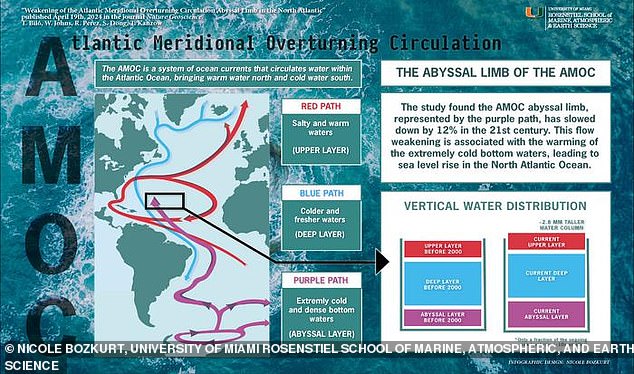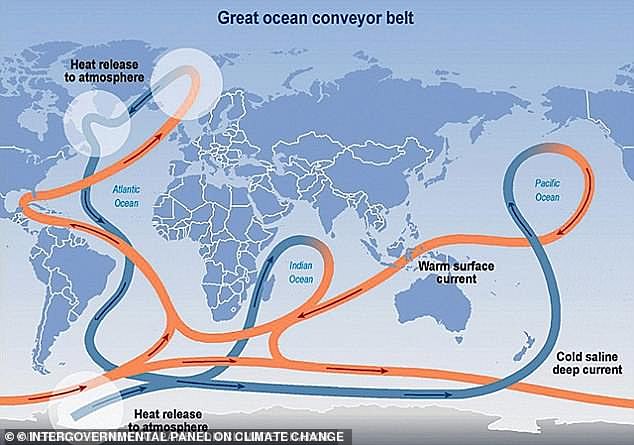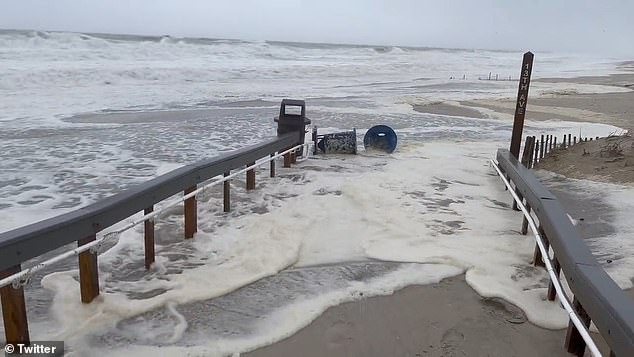The East Coast of the United States is expected to experience sea level rise in the coming decades, but a new discovery could accelerate the timeline.
Researchers at the University of Miami found that a critical ocean current that brings cold water to the North Atlantic from around Antarctica slowed by 12 percent between 2000 and 2020 to increase, but predicts it could fall to 15 percent by 2050.
The weakened current, called the abyssal branch, is part of the Atlantic Meridional Overturning Circulation (AMOC), a system of ocean currents that acts as a “conveyor belt” to distribute heat, nutrients and carbon dioxide throughout our oceans.
Because colder water does not flow abundantly into the North Atlantic, ocean temperatures will rise and cause water to expand, putting millions of Americans at risk of coastal flooding.
The East Coast of the United States is expected to experience sea level rise in the coming decades, but a new discovery could accelerate the timeline. Pictured is Seaside Park, New Jersey, when Storm Ophelia hit in 2023.
Tiago Bilo, lead author of the study, said in a statement: ‘Although this number may seem small, the areas affected by this warming span thousands of kilometers in north-south and east-west directions in the deep sea (between 4 and 6 kilometers deep).
“As a result, there is a significant increase in the heat content of the deep ocean, which contributes to local sea level rise due to thermal expansion of water.”
Bilo went on to explain that the weakening from 2000 to 2020 increased sea level by 2.8 millimeters.
Scientists have long studied AMOC for fear it could collapse, but even a weakening could alter weather patterns, affect marine life, change temperatures and increase flooding.
The current has different layers (upper, deep and abyssal) that move water around the world.
The upper layer transports warm water from the subtropical South Atlantic Ocean across the equator northward to high latitudes in the North Atlantic, where it cools, sinks, and flows toward the equator as cold, deep water.
The abyssal arm carries denser water from the edge of the Antarctic ice, which flows north along the seafloor to the North Atlantic, where it slowly rises and mixes with other waters flowing back south.
The deep sea current includes Antarctic bottom water (ABW), which forms from the cooling of seawater in the Southern Ocean around Antarctica during the winter months.
ABW sinks to the ocean floor and moves northward, driving the AMOC abyssal member.
The researchers partnered with the National Oceanic and Atmospheric Administration (NOAA) for the study, which was conducted using two decades of oceanographic data collected by mooring observation programs.
A mooring is a set of devices connected to a boat and anchored to the seabed.

The weakened current, called the abyssal branch, is part of the Atlantic Meridional Overturning Circulation (AMOC), a system of ocean currents that acts as a “conveyor belt” to distribute heat, nutrients and carbon dioxide throughout our oceans.

Scientists have long studied AMOC for fear it could collapse, but even weakening could alter weather patterns, affect marine life, change temperatures and increase flooding.
The data allowed the team to see how ABW trapped around Antarctica could affect the North Atlantic Ocean.
As sea ice forms, it releases salt into the surrounding water, increasing its density. This dense water sinks to the ocean floor, creating a layer of cold, dense water that spreads northward to fill the three ocean basins: the Indian, Pacific, and Atlantic oceans.
During the 21st century, researchers observed that the flow of this Antarctic layer along latitude 16°N in the Atlantic had slowed, reducing the entry of cold waters to higher latitudes and causing warming of waters in the depths of the ocean.
Lead author Tiago Biló said: “Although these regions are tens of thousands of kilometers away from each other and the abyssal areas are a few kilometers below the ocean surface, our results reinforce the notion that even the most remote areas of the world’s oceans are not untouched.” by human activity.’
Climate scientists have long sounded the alarm about rising sea levels along the East Coast of the United States.
The New York City Panel on Climate Change (NPCC) said in January that sea levels around New York City could rise by a foot in the 2030s, leading to tropical storms and higher temperatures.
NOAA found in 2022 that more than 56 million people living along the U.S. East Coast and Gulf of Mexico are projected to experience at least 10 times more high-tide flooding days by 2050 due to sea level rise as a result of climate change.


